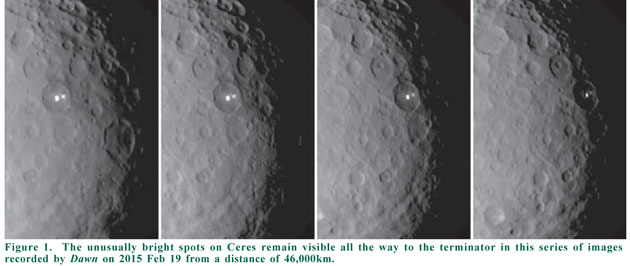NASA’s Dawn spacecraft closes in on Ceres
2015 March 26
 Dwarf planet Ceres, the largest asteroid in the Main Belt, measuring some 950km in diameter on average, should soon reveal some of her secrets. NASA’s Dawn spacecraft went into orbit around this mysterious world on March 6.
Dwarf planet Ceres, the largest asteroid in the Main Belt, measuring some 950km in diameter on average, should soon reveal some of her secrets. NASA’s Dawn spacecraft went into orbit around this mysterious world on March 6.
Recently, the detection of significant amounts of water vapour around Ceres by ESA’s Herschel Space Telescope sparked considerable interest and excitement among astronomers, who speculated on the possible existence of cryo-geysers expelling ice into space from localised regions on its surface. It has also been suggested that Ceres may be a differentiated asteroid with a rocky core and an icy mantle, which may even harbour an internal ocean of liquid water under its surface. Its gravity may also be sufficient to hold on to an extremely thin atmosphere of some kind.
As Dawn approached the planet, a very bright spot was detected, which when seen from closer up was resolved into two separate spots of remarkably high reflectivity located within a 92km diameter impact crater. These can be seen clearly in the series of images in Figure 1 and they may be partly responsible for the escape of water vapour from the interior of this enigmatic body.
At the time of writing, the resolution of the images was insufficient to reveal the true nature of these spots, which occupy single pixels, meaning they measure no larger than 4km across. In a press conference on March 2 at the Jet Propulsion Laboratory, Pasadena, California, deputy principal investigator Dr Carol Raymond commented that ‘The association with the impact crater may indicate that impact heating resulted in exposure of underlying ice, its vaporisation, and perhaps we are seeing a deposit left behind which is rich in material like salts.’
The possibility also exists that some of the reflective material comprises exposed ice, the sublimation of which feeds water vapour into space, its presence having been clearly detected by Herschel. Such a scenario begs the question as to how such ice is replenished from the interior of Ceres. A global map of the dwarf planet was also shown at the JPL conference, reproduced here as Figure 2.
Dawn is currently spiralling down to its first science orbit, which will be reached on April 23. The probe will then study Ceres from a series of orbits, the last of which will be reached in December taking it to within 380km of the dwarf planet’s surface. The mission is scheduled to end in 2016 June.
Richard Miles, Director, Asteroids & Remote Planets Section
| The British Astronomical Association supports amateur astronomers around the UK and the rest of the world. Find out more about the BAA or join us. |
